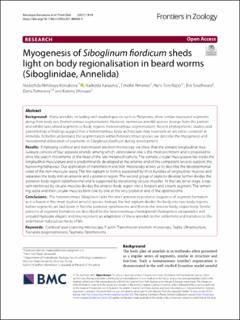| dc.contributor.author | Rimskaya-Korsakova, Nadezhda | |
| dc.contributor.author | Karaseva, Nadezda | |
| dc.contributor.author | Pimenov, Timofei | |
| dc.contributor.author | Rapp, Hans Tore | |
| dc.contributor.author | Southward, Eve | |
| dc.contributor.author | Temereva, Elena | |
| dc.contributor.author | Worsaae, Katrine | |
| dc.date.accessioned | 2022-04-11T08:18:01Z | |
| dc.date.available | 2022-04-11T08:18:01Z | |
| dc.date.created | 2022-02-07T08:53:09Z | |
| dc.date.issued | 2021 | |
| dc.identifier.issn | 1742-9994 | |
| dc.identifier.uri | https://hdl.handle.net/11250/2990866 | |
| dc.description.abstract | Background
Many annelids, including well-studied species such as Platynereis, show similar structured segments along their body axis (homonomous segmentation). However, numerous annelid species diverge from this pattern and exhibit specialised segments or body regions (heteronomous segmentation). Recent phylogenomic studies and paleontological findings suggest that a heteronomous body architecture may represent an ancestral condition in Annelida. To better understand the segmentation within heteronomous species we describe the myogenesis and mesodermal delineation of segments in Siboglinum fiordicum during development.
Results
Employing confocal and transmission electron microscopy we show that the somatic longitudinal musculature consists of four separate strands, among which ventrolateral one is the most prominent and is proposed to drive the search movements of the head of the late metatrochophore. The somatic circular musculature lies inside the longitudinal musculature and is predominantly developed at the anterior end of the competent larva to support the burrowing behaviour. Our application of transmission electron microscopy allows us to describe the developmental order of the non-muscular septa. The first septum to form is supported by thick bundles of longitudinal muscles and separates the body into an anterior and a posterior region. The second group of septa to develop further divides the posterior body region (opisthosoma) and is supported by developing circular muscles. At the late larval stage, a septum reinforced by circular muscles divides the anterior body region into a forepart and a trunk segment. The remaining septa and their circular muscles form one by one at the very posterior end of the opisthosoma.
Conclusions
The heteronomous Siboglinum lacks the strict anterior to posterior sequence of segment formation as it is found in the most studied annelid species. Instead, the first septum divides the body into two body regions before segments are laid down in first the posterior opisthosoma and then in the anterior body, respectively. Similar patterns of segment formation are described for the heteronomous chaetopterid Chaetopterus variopedatus and serpulid Hydroides elegans and may represent an adaptation of these annelids to the settlement and transition to the sedentarian-tubiculous mode of life. | en_US |
| dc.language.iso | eng | en_US |
| dc.publisher | BioMed Central | en_US |
| dc.rights | Navngivelse 4.0 Internasjonal | * |
| dc.rights.uri | http://creativecommons.org/licenses/by/4.0/deed.no | * |
| dc.title | Myogenesis of Siboglinum fiordicum sheds light on body regionalisation in beard worms (Siboglinidae, Annelida) | en_US |
| dc.type | Journal article | en_US |
| dc.type | Peer reviewed | en_US |
| dc.description.version | publishedVersion | en_US |
| dc.rights.holder | Copyright 2021 The Author(s) | en_US |
| dc.source.articlenumber | 44 | en_US |
| cristin.ispublished | true | |
| cristin.fulltext | original | |
| cristin.qualitycode | 1 | |
| dc.identifier.doi | 10.1186/s12983-021-00426-9 | |
| dc.identifier.cristin | 1998342 | |
| dc.source.journal | Frontiers in Zoology | en_US |
| dc.identifier.citation | Frontiers in Zoology. 2021, 18, 44. | en_US |
| dc.source.volume | 18 | en_US |
| dc.source.issue | 1 | en_US |

